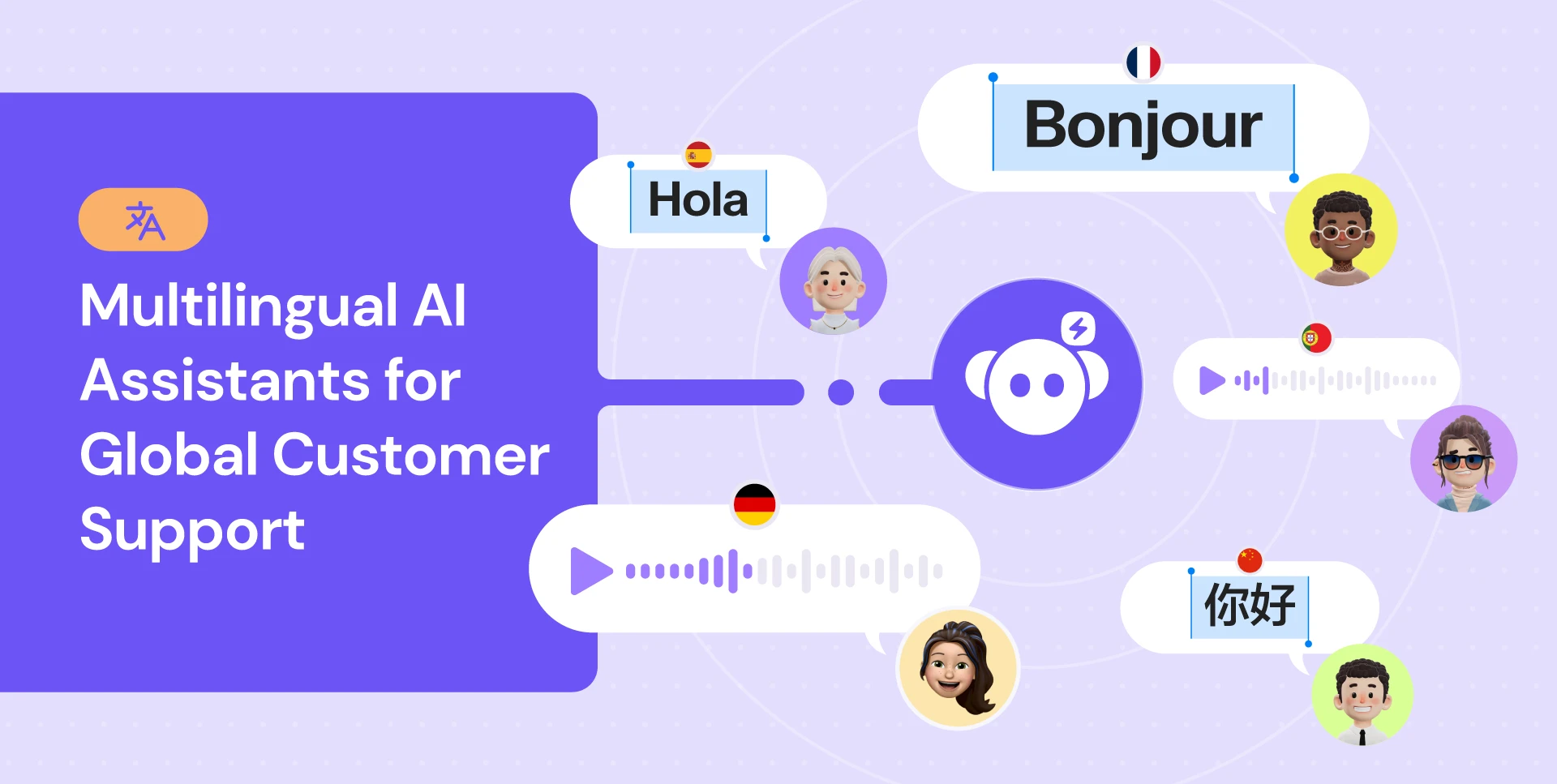Deploying Multilingual AI Assistants and Supporting Customers in 100+ Languages
• Customer Support
• FastBank

Picture a scenario where a major tech corporation based in the United States has outsourced its customer support service to a Business Process Outsourcing (BPO) firm located in the Philippines or India. Even though English proficiency may be high in these settings, understanding the nuances and subtleties of American slang and idioms may not be a given.
So, while the BPOs may boast competent agents, lacking multilingual and multicultural fluency can result in misunderstandings, inefficiencies, and, ultimately, a poor customer experience.
Why does this matter, how can it be addressed, and what role can AI have in all of this?
The answers are simple - in today's interconnected world, where businesses operate on a global scale and serve customers from diverse cultural backgrounds, the need for effective multilingual customer support is crucial. This is where the concept of deploying multilingual AI assistants comes into play.
In this article, we'll talk about the role of AI in delivering exceptional customer support in 100+ languages.
Let's get started!
The Role of Multilingual AI Assistants in Customer Support
The modern world is rapidly globalizing, blurring borders, and transcending linguistic boundaries across different markets.
In fact, a CSA Research study has discovered quite interesting facts about people's shopping habits based on the languages they face during their user journey. Here they are:
-
65% of online shoppers prefer buying products with the information provided in their native language.
-
73% of online shoppers want to see product reviews in their mother tongue.
-
60% of customers expect customer service in their native language.
-
40% of customers won't make a purchase if the buying experience is in another language.
These statistics highlight the importance of language in the customer experience journey. Businesses must adapt to this reality to effectively engage with their diverse customer base.
In this context, the role of multilingual AI assistants in customer support becomes critical. These AI assistants can bridge language gaps, providing seamless support to customers regardless of their native tongue. By leveraging multilingual AI technology, businesses can enhance customer satisfaction, drive sales, and build stronger relationships with their global clientele.
How Multilingual AI Understands and Translates
Multilingual AI assistants possess a remarkable ability to understand and translate languages with a level of sophistication that mimics human comprehension. At the heart of their operation lies advanced natural language processing (NLP) algorithms, enabling them to decode the intricacies of different languages.
Multilingual AI's capability to understand and translate languages stems from a complex interplay of advanced technologies, primarily driven by natural language processing and machine learning algorithms. At its core, NLP enables AI systems to analyze and comprehend human language by breaking down text or speech into smaller components, such as words, phrases, and syntactic structures. Through techniques like tokenization, part-of-speech tagging, and parsing, NLP algorithms extract meaningful information from input data, facilitating comprehension across languages.
Once the input text or speech is parsed and understood, multilingual AI relies on machine learning algorithms to translate it into the desired languages. Machine learning models are trained on vast amounts of bilingual and multilingual data to learn patterns and relationships between languages. Techniques such as neural machine translation (NMT) have significantly advanced the accuracy and fluency of translation via deep learning architectures to predict the most probable translation for a given input.
Here's how the process goes beyond theory: When a customer interacts with a multilingual AI assistant, their query is first resolved into components and understood in its original language. The AI then utilizes its language model to translate the query into the desired language, ensuring accuracy and coherence in the translation process. This translation is not just word-for-word but also considers idiomatic expressions, cultural nuances, and context to provide meaningful responses. These models continuously learn and improve over time through feedback mechanisms, refining their translation capabilities based on real-world usage and human feedback.
Deploying Multilingual AI Assistants: Strategies and Tips
Similar to individuals, AI assistants also undergo a learning curve when it comes to language comprehension. Managing the AI assistant's learning process is essential to maximize its effectiveness as a communication tool for your business.
Here are some points to consider when building your multilingual AI assistant:
-
Contextual Understanding: Any successful communication is built upon a particular context. It's important to equip your AI assistant to distinguish the context surrounding a conversation and form a response accordingly.
-
Language Auto-Detection: Incorporate a mechanism that can automatically detect the conversation language and engage in the user's native language without the need for any changes on the user's part.
-
Transliteration: As an extension to language auto-detection, transliteration is another crucial aspect of a multilingual AI assistant's functional package. The transliteration process suggests converting text between different writing systems while retaining its phonetic integrity. In other words, if a user asks something in Armenian but with Latin characters, the system recognizes it as Armenian and replies using the Armenian alphabet.
-
Ongoing Training: AI assistants refine their capabilities through continuous training. Regularly update and refresh the training data to make sure your AI-powered virtual assistant can address the evolving user needs and preferences.
-
Fail-Safe Measures: AI assistants may encounter queries beyond their scope despite comprehensive training. In such instances, having an effective fail-safe mechanism to transfer the inquiry to a live agent is crucial to maintaining a smooth user experience.
By keeping these considerations under control, you can enhance the engagement and effectiveness of your multilingual AI assistant, ensuring it serves as a valuable asset in your business's communication strategy.
Case Studies: Multilingual AI in Action
With the advent of multilingual AI, companies worldwide are breaking down linguistic boundaries and reaching audiences like never before. Let’s explore some compelling case studies that demonstrate the transformative power of multilingual AI in action:
Uber: As a multinational transportation network company, Uber relies on multilingual AI to ensure seamless communication between drivers and passengers from diverse linguistic backgrounds. With its app available in over 60 languages, Uber utilizes AI-driven language recognition to match users with drivers who speak their preferred language.
TripAdvisor: Known as a leading travel platform, TripAdvisor understands the importance of catering to international travelers. Through multilingual AI, TripAdvisor offers language-specific recommendations, reviews, and travel guides to users worldwide. It enables travelers to access valuable information in their native language, empowering them to make informed decisions.
Google Maps: With its AI-driven language recognition features, Google Maps enables users to navigate roads, find nearby businesses, and discover points of interest in their preferred languages. Whether exploring new cities, commuting to work, or planning road trips, Google Maps' multilingual AI enhances the user experience, helping individuals navigate the world easily.
Hoory AI: With fluency in over 100 languages, Hoory AI takes charge of customer support, effortlessly handling queries in any language and cultural context. Whether in Latin script or another alphabet, Hoory AI responds in the very language of the query, communicating like a native speaker to ensure seamless interaction. See Ucraft's use case in the video below: initially trained in English, Hoory AI seamlessly replies to customer enquiry typed in Spanish.
Conclusion
As businesses strive to cater to diverse linguistic demographics, the role of multilingual AI in facilitating seamless communication cannot be overstated.
Through this article, we have explored the intricate workings of multilingual AI, from its fundamental understanding of languages to its translation capabilities driven by sophisticated natural language processing and machine learning algorithms.
In closing, the integration of multilingual AI assistants marks a significant leap forward in customer support, promising a world where communication is seamless, inclusive, and truly global.

























